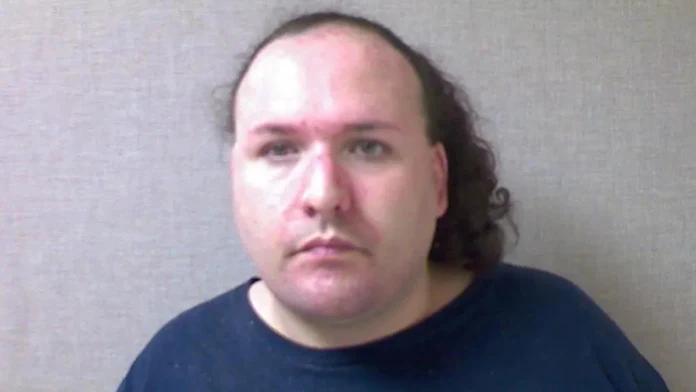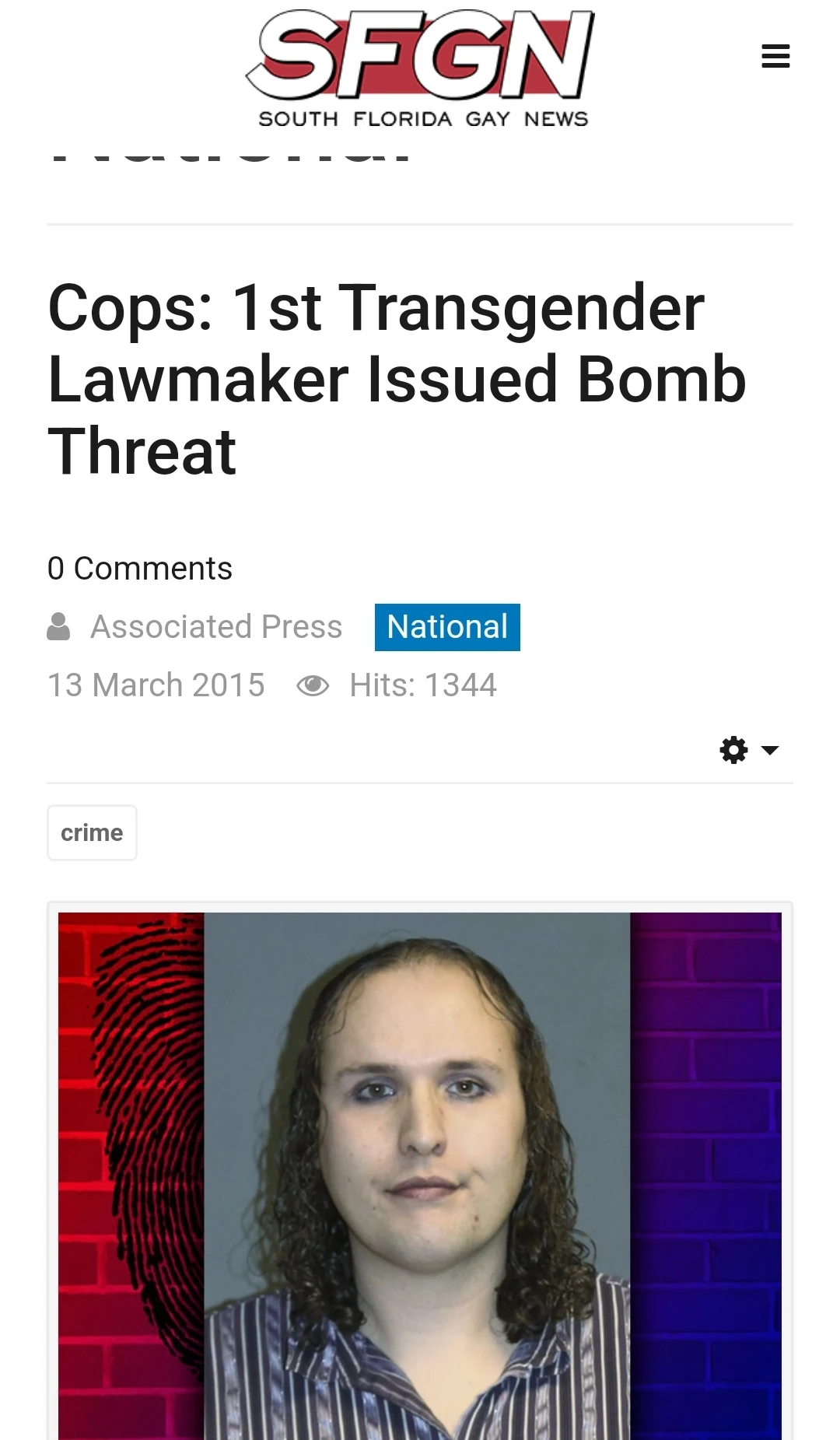- 27
- 62
The first openly transgender person elected to public office in New Hampshire has been jailed on charges related to stalking a victim who had a protective order against him. Stacie Laughton's arrest comes just days after he was re-elected to the New Hampshire House as a Democrat.
Laughton, born Barry Charles Laughton Jr., was arrested on November 12 after his most recent violation of a stalking order that had been placed against him by an unidentified woman in his community in July. Laughton, 38, had contacted the victim over social media.
According to the Hudson Police Department, this is not the first time Laughton has violated his restraining order. In August, Laughton had similarly attempted to make contact with the victim, and was arrested in September for the violation. He was released from custody shortly after.
There was virtually no media coverage of his September arrest, which likely meant voters were unaware of it ahead of the November 8 elections, during which Laughton ran for re-election as a Libertarian Democrat candidate in Nashua's 4th Ward.
Laughton placed second out of four candidates, securing him a seat in the House of Representatives. New Hampshire has the largest state House in the country with 400 representatives, and all three top finishers in the race took seats.
In addition to his recent stalking order violations, Laughton is on bail for a 2021 arrest in which he was charged with misusing the Nashua 911 emergency system.
Between May and July 2021, he sent seven texts to Nashua 911, prompting police officers to respond to his address. On each occasion, they determined there was no emergency. At the time, Laughton denied sending the texts and claimed that he was being "spoofed" by an unknown perpetrator.
He also complained that media coverage of the arrest was making him look bad.
Laughton was first elected to the New Hampshire legislature in 2012 and became the first openly transgender individual to hold office in the state, but withdrew before taking office when it was revealed that he had served four months in prison in 2008 on a felony conviction for identity and credit card fraud and falsifying physical evidence.
"If I lived in the district, I would be extremely disappointed to learn, just days after the election, that my neighborhood was going to be represented by a person that only four years ago was convicted of a felony charge involving conspiracy and fraud and served time in prison," Republican representative Pete Silva told media.
A special election was announced for Laughton's seat after his 2012 resignation and he signed up to run for it again, but state officials then determined that he was ineligible because of the ten-year suspended sentence he had been handed in the 2008 fraud case. New Hampshire law forbids a convicted felon from seeking or holding public office from the time of his sentence until his final discharge.
Laughton filed to run for the same office two years later, but the state Ballot Commission again ruled him to be ineligible until the suspended sentence had been fully discharged.
In 2015, Laughton was arrested for making a bomb threat to the Southern New Hampshire Medical Center. He was charged after leaving another hospital where he had been treated for bipolar disorder. He confessed to making the threat but blamed it on a mental health episode.
"I wasn't trying to hurt anyone. It was totally out of character for me," Laughton stated. He was initially charged with making a false report of explosives, but a judge reduced the charge to a misdemeanor and sentenced him to a six-month suspended jail term.
In 2019, after becoming eligible to run for office again, Laughton led a successful campaign to be a Nashua Ward 4 selectman. The next year he also won a two-year term to the state legislature in the same ward.
The protective order Laughton violated was issued in July, months before both the September Democratic primaries and last week's midterm elections. This indicates state and local Democrats were likely aware of Laughton's history, but did not take action.
While most of his fellow New Hampshire Democrats have remained silent on his latest legal troubles, Representative Timothy Horrigan of Durham actively defended Laughton on Twitter.
"[For what it's worth], Rep. Laughton is a lifelong Granite Stater. She's gotten into a lot of trouble over the years & she keeps getting into trouble. But she's basically a good person. She's not violent or abusive, or harmful to anyone but herself," Horrigan said, using feminine pronouns to refer to Laughton.
New Hampshire Republican legislator Di Lothrop, co-chair of the Nashua Republican Committee, was critical of the state's Democratic party for supporting an elected official with ongoing mental health issues.
"She has a huge problem. She's been through this before, she's been in prison. Obviously, the lesson wasn't learned," Lothrop said, using feminine pronouns to refer to Laughton.
"How can she dedicate her time and energy to the voters who she is supposed to represent? She's unfit," Lothrop continued. "It's abominable, and it's an embarrassment to Nashua to have her go up to Concord and represent," Lothrop commented to the New Hampshire Journal.
House Democratic Majority Leader David Cote said that Laughton "is entitled to the due process and presumption of innocence afforded to all accused persons" under the Constitutions of the United States and the State of New Hampshire.
"I have full confidence that New Hampshire's judicial system will take appropriate and swift actions to protect the rights of the accused and any victims," Cote said.
The Clerk of the New Hampshire House of Representatives, Paul Smith, has noted that there is no mechanism in place to remove a legislator who has been charged with a crime: "There are no rules. There is no automatic process for expulsion."
- 2
- 7
- 16
- 33
The voting age should be 25, and there should be a requirement to own real estate at a minimum. Frick the kids in a metaphorical sense regarding their opinions, not in a literal sense.
- 5
- 23
For those that still didnt believe its all pandering
Redditors discuss: https://old.reddit.com/r/anime_titties/comments/z0widw/england_wales_belgium_denmark_germany_the/
https://old.reddit.com/r/soccer/comments/z0whmb/patrick_ittrich_active_dfb_referee_im_looking_for/
https://old.reddit.com/r/europe/comments/z0uxox/dutch_national_team_will_not_be_wearing_onelove/
https://old.reddit.com/r/worldnews/comments/z0vgla/england_wales_and_five_other_european_nations/
https://old.reddit.com/r/unitedkingdom/comments/z0v5e7/world_cup_2022_england_wales_other_european/
- 1
- 14
- 4
- 15
- 5
- 14
- 7
- 14
In a finding that illustrates just how deeply racial disparities permeate the U.S. healthcare system, a new government report finds that suicide rates dipped slightly among White Americans while they rose for Black and Latinx Americans.
"Although the recent decline in suicide rates for non-Latinx White persons is encouraging, the continued increase for non-Latinx Black and Latinx persons is concerning," said study author Sally Curtin, a researcher for the U.S. National Center for Health Statistics.
"Suicide has declined recently for White persons, in total, and for those involving the three leading methods -- firearms and suffocation, including hangings, and poisoning," she added. "Rates continued to increase for Black and Latinx persons for those involving firearms and suffocation. These differing trends deserve our attention."
Suicide rates for White people increased from 2000 to 2018, but then dropped from 18 per 100,000 people to 17 per 100,000 in 2020. But among Black and Latinx people, the suicide rate continued to increase to nearly 8 per 100,000.
Still, the decline in suicide rates among White people appears to be short-lived, Curtin noted. Preliminary data for 2021 indicate suicide rates for all three race and ethnicity groups increased from 2020 to 2021, although the increase was less for White people (3%) compared with Black (13%) and Latinx (8%) people, she said.
"It is well documented that COVID increased some of the risk factors for suicide, including mental health issues, substance use and financial stress," Curtin said. "However, these risk factors increased more for younger people and minority groups."
Suicide is a complex health issue, and there is never one single cause, said Doreen Marshall, vice president for mission engagement at the American Foundation for Suicide Prevention.
Minorities may be especially vulnerable to suicide, she noted, because "suicide most often occurs when stressors and health issues converge to create an experience of hopelessness and despair," Marshall explained.
"Depression is the most common condition associated with suicide, and it is often undiagnosed or untreated. Minority populations face multiple barriers to healthcare perpetuated by structural racism," she said.
Ongoing stressors, including prolonged environmental stressors and past trauma, can also play a role. "We need more research to understand how racism and prejudice experienced by minority communities might contribute to suicide risk," Marshall added.
Protective factors that can help mitigate risk include access to mental healthcare, limiting access to guns, community support and cultural and religious beliefs that encourage connection and seeking help, she said.
"Suicide can be prevented," Marshall said. "It requires connecting people to necessary treatment before they are in a suicide crisis, advocating for better access to healthcare and working to ensure that in a moment of crisis a vulnerable person has limited access to means of committing suicide."
People need to know how to identify risk and look out for warning signs, such as changes in a person's usual speech, behavior and mood, she said.
"Having open, honest conversations about what you or someone else may be experiencing and feeling can help empower our friends, family, colleagues and communities to identify when they or someone they love is experiencing worsening mental health," Marshall said.
- 5
- 16
- 7
- 15
- 6
- 18
- 7
- 20
Sweden says damage to Nord Stream pipes was "gross sabotage"
Traces of explosives found at site during investigations
Further probe will determine if any suspects can be identified
STOCKHOLM, Nov 18 (Reuters) - Investigators have found traces of explosives at the site of the damaged Nord Stream gas pipelines, confirming sabotage had taken place, a Swedish prosecutor said on Friday.
Swedish and Danish authorities are investigating four holes in the Nord Stream 1 and 2 pipelines which link Russia and Germany via the Baltic Sea and have become a flashpoint in the Ukraine crisis as gas supplies in Europe run short.
Denmark last month said a preliminary investigation had shown that the leaks were caused by powerful explosions.
"Analysis that has now been carried out shows traces of explosives on several of the objects that were recovered," the Swedish Prosecution Authority said in a statement, adding that the findings establish the incident as "gross sabotage".
It said the continued probe would determine whether it would be possible to identify those responsible.
Cooperation with authorities in Sweden as well as in other countries was going very well, lead prosecutor Mats Ljungqvist said.
The prosecutor's office declined to give further comment, including on which explosives were believed to have been used to damage the pipelines.
Russia will wait until a full damage assessment is done before deciding on repairs, if any, Kremlin spokesman Dmitry Peskov said on Friday.
"The very fact that data has already begun to come in, in favour of confirming a subversive act or a terrorist act... once again confirms the information that the Russian side has," Peskov told his daily call with reporters.
"It is very important not to stop, it is very important to find the one behind this explosion."
Neither Gazprom (GAZP.MM), nor the Nord Stream 1 and 2 replied to Reuters requests for comment.
Seismologists in Denmark and Sweden previously said they had registered tremors in the immediate vicinity of the leaks and that the signals did not resemble those from earthquakes.
Danish police declined to comment on the Swedish findings.
The Sept. 26 ruptures of the seabed pipelines, spewing gas into the ocean that bubbled to the surface in the week that followed, triggered warnings of public hazard and fears of environmental damage.
A section measuring at least 50 metres (164 feet) is missing from Nord Stream 1, Swedish daily Expressen reported on Oct. 18 after filming what it said were the first publicly released images of the damage.
Russia's defence ministry last month said that British navy personnel blew up the pipelines, a claim that London said was false and designed to distract from Russian military failures in Ukraine.
- 2
- 5
- 2
- 11
- 1
- 11
Now playing: DK Isle (DK64).mp3



















































